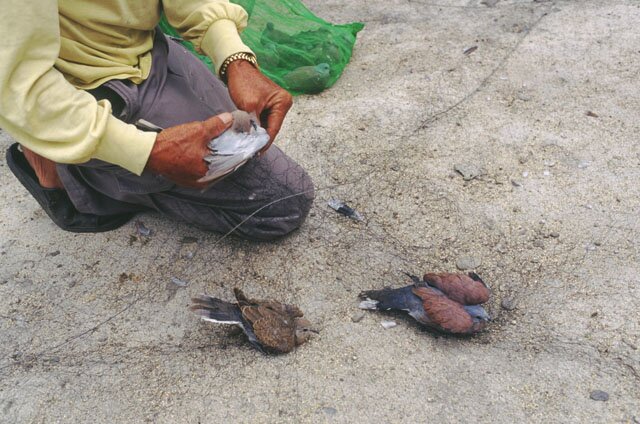BROWSE COUNTRIES/ TERRITORIES
Disappearing deity
India, with half the world’s population of wild tigers, sees red over China’s plans to reopen the trade in tiger parts.
What does the tiger mean to you?
Close your eyes and whisper his name: King of the jungle, deity, symbol of the wild, or this—the magnificent tiger reduced to nothing but luxury products for our vanity and consumption. That may be all that’s left unless the Chinese government keeps its tiger trade ban in place.

At the 14th Conference of Parties to the Convention on the International Trade in Endangered Species of Fauna and Flora (CITES) in The Hague in the Netherlands last month, Chinese tiger breeders called for the lifting of a ban on selling tiger parts.
The global body regulating wildlife trade, however, resisted such calls and instead added pressure on China to reduce the sale of its tiger farming industry.
India, which had teamed up with Nepal and Bhutan, got a huge support when the United States called on China to phase out country's privately run tiger farms housing nearly 5,000 big cats.
After many hours of deliberation and intensive voting, the CITES meeting passed a resolution endorsing captive stocks only where they aid conservation.
Chinese delegate, Wang Weisheng, from the wildlife management division of the government's forestry administration, said the trade would not be re-opened unless it could be shown to have a conservation benefit.
"I wish to assure [CITES] parties that we will not change domestic policy unless it can be demonstrated to have a positive effect on the conservation of wild tigers," he said.
Black market trade
Solid evidence, however, suggests some of these tiger farms are already selling tiger products illegally, and even serving tiger meat to visitors.
Traditionally, the Chinese believe that tiger-related medicines can be used to treat rheumatism and loss of sexual appetite. The owners of tiger farms thus see the tiger as a commercial treasure trove and want to rekindle dwindling markets for tiger bone and skin.
China banned the sale of tiger bones and pelts in 1993, which virtually wiped out the market for traditional medicines made from tigers in what was once the world’s largest consumer of such goods. Since then, a black market has always existed, and if you knew the right questions, you’d find yourself some tiger medicine in the forms of an ointment, wine, pill, capsule, or resin.
I enter a small traditional medicine (TM) shop in Malaysia’s capital city of Kuala Lumpur. I browse around and am soon queried by a salesman: “What are you looking for?” I say I’m looking for something to treat rheumatism, something strong and effective.
Wine tonics are very good, I’m told. Ginseng and deer musk (the latter also a prohibited product) is also very good for blood circulation. Together with tiger bone, it is very effective, the salesman enthuses. I read the list of ingredients on the back of the fancy-packaged bottle.
“But it doesn’t list ‘tiger’ as an ingredient. It’s only in the name isn’t it?” I ask the salesman. He tells me that because tiger products are prohibited, it cannot be listed as an ingredient, but I should be assured that the medicine has tiger bone in it because he has sold it for many decades.
Tiger bones are used to treat virtually everything—from skin disease and convulsions to laziness and malaria. Tiger penis is believed by many to be a powerful aphrodisiac.
Leopards, lions not spared
Although the trade is primarily in tiger products, other Asian big cat species are also not spared. They are often used as substitutes for tiger bone in the medicine trade. Leopard is the most common substitute, and more recently, lions. Both are endangered species in Asia.
Unlike tigers and leopards, which are poached for their pelts and bones to make TM, lion carcasses were not prized on the black market. That seems to have changed.
Valmik Thapar, conservationist and one of the world’s leading experts in Indian tigers, recounts that in the past six months, there have been 12-14 cases of Asiatic lions being poached in Gir National Park, in India’s western state of Gujarat.
“These are the same poaching gangs who target tigers. Obviously it is very difficult to discern lion bones from tiger ones once they are mixed together.” Thapar says it is apparent the lions were poached as part of the tiger trade, because only their bones (as it is with the tigers) were removed, and their carcasses left behind. Paws were also removed to be sold as curios in souvenir or jewellery shops.
Little known, even in India, the 350-odd lions at Gir are the last survivors of a sub-species that once roamed from Greece to eastern India. The lions in Daniel’s biblical den were of this Asiatic kind, smaller than their African cousins, with a lower slung belly.
These survivors in Gujarat—which live, incidentally, alongside 20,000 descendants of African slaves, whose ancestors were freighted to the region two centauries ago—are a rare conservation success. Alas, efforts put in place since the 1900s may not be enough to save the Asiatic lion if tiger breeders have their way at The Hague in June.
Tiger farms—a feasible idea?
China argues that the tigers bred in captivity can one day be released into the wild.
But Bittu Sahgal, spokesperson of a coalition of 35 international NGOs on how it is imperative to stop China from legalising “tiger farms” argues: “It is not feasible by any measure. Tiger experts know this. Bureaucrats and tiger farmers are putting such smokescreens out so they can somehow cash in on the demand for tiger parts.
“If we want tigers to live, we need to give them exclusive areas in which to survive. Here, a myriad plants and animals—biodiversity—will also survive. And these forests, which sequester carbon, will help us counter climate change.”
Thapar cites a case in which a tiger was relocated because of conflict with humans into a forest area of the Sundabans in Northeast India.
“In a day the tiger travelled over 100km and was killed by another tiger four days later. You can’t just take tigers and put them into forests. It’s an intensive and expensive project that can cost up to US$5 million! And it costs only US$500 to poach a tiger.”
These views are shared by over 35 organisations that comprise The Coalition Against Tiger Trade (CATT). They believe China’s 14-year tiger trade ban has had an overwhelming success in reducing trade and demand for the animal’s parts to date.
“That is why we still have tigers around though people had predicted they would die out before 2000,” Sahgal laments, “The problem is that in the past decade the political support for protection of tigers and their forest home has withered.”
“In the crossfire between poaching and habitat loss, one of the most charismatic animals in the world is being lost. Besides, giving tigers space [forests] will also ensure India's water security as over 300 rivers originate from tiger forests.”
Once the numbers are finalised at the end of this year, we could have lost about 2000 Tigers over the past three and a half years, Sahgal says.
When asked what is needed to safeguard the future of tigers, Thapar answers: “Politicians have to stick to one agenda, and that is protection. Protecting our forests. It will take the will of all the people in the world to revive the political will that has been waning. Politicians have to put the protection of our wilderness on the agenda. They’ve already listed climate change as an issue because the people in New York are feeling the effects of the heat.”
“The engagement is with the people,” says Thapar with a breath of conviction, “Six hundred million people look at tigers in zoos every year. There is already interest in tigers, what is needed now is the will.”
FACT BOX:
The tiger is among the world’s most endangered species and is found in Asia and the Russian Far East. Many of the world’s remaining 5000-7000 wild tigers live in some of the most densely populated regions on earth. Despite its high profile, the tiger remains threatened, with habitat loss being the primary cause of its decline throughout its range. Tigers have also long been hunted for sport and regarded as pests, killed to protect humans and livestock.
Tiger in Traditional Medicine
For more than 1000 years now, Asians have been using tiger bone medicine, with the first published reference in China to tiger bone as medicine dating back to 500AD. Since that time, the practice of using tiger bone in medicine has spread from China to Korea, Japan, and throughout the world, wherever there are Asian populations. Trade in tiger skins has also been, and continues to remain strong despite the animals’ already low population numbers—the high price for skins being the primary incentive for hunters.
Related Stories:
Login or Register
 Debby Ng is an environmental photojournalist whose work has been published in several regional and international magazines, including the award-winning Lebanese magazine, Environment & Development. She has also worked with numerous Asian and international non-government organisations such as the TRAFFIC, World Wide Fund for Nature (WWF), World Society for the Protection of Animals (WSPA) and the Environmental Investigation Agency (EIA).
Debby Ng is an environmental photojournalist whose work has been published in several regional and international magazines, including the award-winning Lebanese magazine, Environment & Development. She has also worked with numerous Asian and international non-government organisations such as the TRAFFIC, World Wide Fund for Nature (WWF), World Society for the Protection of Animals (WSPA) and the Environmental Investigation Agency (EIA).
www.debbyng.net
www.pulauhantu.org
- Asian Dynasties and History
- Conservation of the Environment
- Definition: Culture
- Economy and Economics
- Food and Recipe
- Geopolitics and Strategic Relations
- Health and Body
- Of Government and Politics
- Religion and Practices
- Social Injustices and Poverty Report
- Society, Class and Division
- Unrest, Conflicts and Wars
































 Another Point
Another Point From Jerusalem to the West Bank
From Jerusalem to the West Bank
Comments
Post new comment